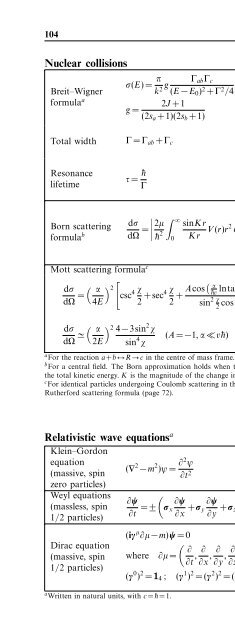Create successful ePaper yourself
Turn your PDF publications into a flip-book with our unique Google optimized e-Paper software.
104 Quantum physics<br />
Nuclear collisions<br />
σ(E)= π Breit–Wigner<br />
k 2 g Γ ab Γ c<br />
(E −E 0 ) 2 +Γ 2 /4<br />
formula a 2J +1<br />
g =<br />
(2s a +1)(2s b +1)<br />
(4.174)<br />
(4.175)<br />
Total width Γ=Γ ab +Γ c (4.176)<br />
Resonance<br />
lifetime<br />
Born scattering<br />
formula b<br />
τ = ¯h Γ<br />
∣ ∫<br />
dσ ∣∣∣<br />
dΩ = 2µ ∞<br />
¯h 2<br />
0<br />
sinKr<br />
Kr<br />
(4.177)<br />
2<br />
V (r)r 2 dr<br />
∣<br />
(4.178)<br />
Mott scattering formula c<br />
dσ<br />
( α<br />
) 2<br />
[csc<br />
dΩ = 4 χ χ 4E 2 +sec4 2 + Acos( α<br />
¯hv lntan2 χ )]<br />
2<br />
sin 2 χ 2 cos χ 2<br />
(4.179)<br />
dσ<br />
( α<br />
) 2 4−3sin 2<br />
dΩ ≃ χ<br />
2E sin 4 (A = −1,α≪ v¯h) (4.180)<br />
χ<br />
σ(E) cross-section for a+b → c<br />
k incoming wavenumber<br />
g spin factor<br />
E total energy (PE + KE)<br />
E 0 resonant energy<br />
Γ width <strong>of</strong> resonant state R<br />
Γ ab partial width into a+b<br />
Γ c partial width into c<br />
τ resonance lifetime<br />
J total angular momentum<br />
quantum number <strong>of</strong> R<br />
s a,b spins <strong>of</strong> a and b<br />
dσ<br />
dΩ differential collision<br />
cross-section<br />
µ reduced mass<br />
K = |k in −k out | (see footnote)<br />
r radial distance<br />
V (r) potential energy <strong>of</strong> interaction<br />
¯h<br />
α/r<br />
χ<br />
v<br />
A<br />
(Planck constant)/2π<br />
scattering potential energy<br />
scattering angle<br />
closing velocity<br />
= 2 for spin-zero particles, = −1<br />
for spin-half particles<br />
a For the reaction a+b ↔ R → c in the centre <strong>of</strong> mass frame.<br />
b For a central field. <strong>The</strong> Born approximation holds when the potential energy <strong>of</strong> scattering, V , is much less than<br />
the total kinetic energy. K is the magnitude <strong>of</strong> the change in the particle’s wavevector due to scattering.<br />
c For identical particles undergoing Coulomb scattering in the centre <strong>of</strong> mass frame. Nonidentical particles obey the<br />
Rutherford scattering formula (page 72).<br />
Relativistic wave equations a<br />
Klein–Gordon<br />
equation<br />
(massive, spin<br />
zero particles)<br />
Weyl equations<br />
(massless, spin<br />
1/2 particles)<br />
Dirac equation<br />
(massive, spin<br />
1/2 particles)<br />
a Written in natural units, with c =¯h =1.<br />
(∇ 2 −m 2 )ψ = ∂2 ψ<br />
∂t 2 (4.181)<br />
(<br />
)<br />
∂ψ<br />
∂t = ± ∂ψ<br />
σ x<br />
∂x +σ ∂ψ<br />
y<br />
∂y +σ ∂ψ<br />
z<br />
∂z<br />
(4.182)<br />
(iγ µ ∂µ−m)ψ = 0 (4.183)<br />
( )<br />
∂<br />
where ∂µ=<br />
∂t , ∂<br />
∂x , ∂<br />
∂y , ∂<br />
(4.184)<br />
∂z<br />
(γ 0 ) 2 = 1 4 ; (γ 1 ) 2 =(γ 2 ) 2 =(γ 3 ) 2 = −1 4 (4.185)<br />
ψ wavefunction<br />
m particle mass<br />
t time<br />
ψ spinor wavefunction<br />
σ i Pauli spin matrices<br />
(see page 26)<br />
i i 2 = −1<br />
γ µ Dirac( matrices: )<br />
γ 0 12 0<br />
=<br />
0 −1<br />
( ) 2<br />
γ i 0 σi<br />
=<br />
−σ i 0<br />
1 n n×n unit matrix


